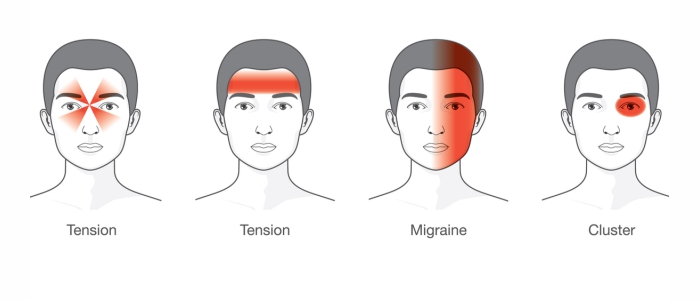Headaches are a common health issue that affects millions of people worldwide. While many are harmless and short-lived, others can be severe, chronic, and life-disrupting. Each type of headache has its cause, symptoms, and treatment approach. By understanding the differences, individuals can better manage their symptoms and avoid triggers. Whether caused by stress, hormones, or environmental changes, headaches are not all the same. Let’s explore the seven main types and how to recognize and treat them.
1. Tension Headaches
Tension headaches are the most frequent type and are often linked to stress or muscle strain. They cause a dull, aching pain on both sides of the head, sometimes described as a tight band around the skull. Pain usually builds gradually and doesn’t worsen with physical activity. Common triggers include anxiety, fatigue, and poor posture. These headaches typically don’t cause nausea or visual issues. Over-the-counter painkillers and relaxation techniques are effective treatments.
2. Migraine Headaches
Migraines are intense headaches often accompanied by nausea, vomiting, and light sensitivity. The pain is usually throbbing and localized to one side of the head. Some individuals experience warning signs called “auras,” such as flashing lights or blind spots. Triggers include hormonal changes, certain foods, sleep disturbances, and stress. Migraines can last from a few hours to several days and often interfere with daily activities. Treatment may include prescription medications and avoiding known triggers.
3. Cluster Headaches
Cluster headaches are rare but extremely painful, often waking sufferers from sleep. They typically occur in cycles, affecting one side of the head, particularly around the eye. Symptoms include tearing, redness of the eye, nasal congestion, and agitation. Each attack can last 15 minutes to 3 hours and may occur several times a day. The exact cause is unknown, but it’s linked to the body’s internal clock. Oxygen therapy and medications like sumatriptan are commonly used.
4. Sinus Headaches
Sinus headaches result from inflamed or infected sinuses and cause pain in the forehead, cheeks, and around the eyes. They often accompany a stuffy nose, facial pressure, and sometimes fever. The pain usually worsens when bending forward or lying down. These headaches are common during colds, sinus infections, or allergy seasons. Treating the underlying sinus condition is key—this may involve decongestants, antihistamines, or antibiotics. Steam inhalation and staying hydrated can also provide relief.
5. Rebound Headaches
Rebound headaches happen when headache medication is taken too frequently, leading to dependency. Overuse of painkillers like ibuprofen, acetaminophen, or triptans can cause headaches to return once the drug wears off. These headaches are typically daily or very frequent, and relief is short-lived. Gradually reducing medication under medical guidance is the best treatment. Preventive strategies and alternative pain management options are often recommended. Avoiding overuse in the first place is crucial to prevention.
6. Hormonal Headaches
Hormonal headaches mainly affect women and are linked to fluctuations in estrogen levels. These often occur around menstruation, pregnancy, or menopause. The pain may resemble a migraine and can include nausea, light sensitivity, and throbbing discomfort. Birth control pills or hormone therapy may either help or worsen the condition, depending on the individual. Tracking cycles and symptoms helps identify patterns and manage triggers. Some women benefit from magnesium supplements or lifestyle changes.
7. Caffeine-Withdrawal Headaches
Caffeine-withdrawal headaches arise when someone suddenly stops consuming caffeine after regular use. Pain is usually mild to moderate and accompanied by fatigue, mood swings, or difficulty concentrating. These headaches typically begin 12–24 hours after the last dose of caffeine. The best way to prevent them is to gradually reduce caffeine intake. Drinking plenty of water and resting can ease the transition. Over-the-counter medications can provide temporary relief during withdrawal.
Best Neurologist in Lahore – Book Online Appointment
Final Thoughts
Not all headaches are created equal—each type has its symptoms and causes. Identifying the correct type of headache is crucial for choosing the right treatment. Many can be managed through lifestyle changes, medication, or by avoiding known triggers. Keeping a headache diary can help track patterns and identify causes. If headaches are frequent or severe, consulting a doctor is essential. For accurate diagnosis, especially in complex cases, consider scheduling a scan—Alnoor Lab MRI Brain with Contrast – Book Here for quick and reliable testing.

